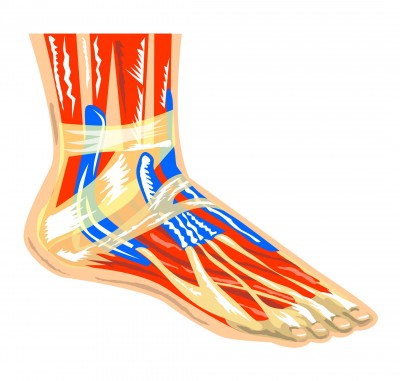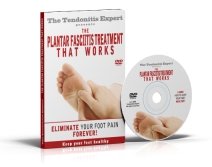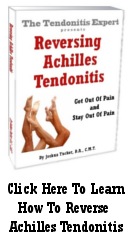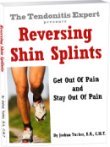|
Peroneal TendonitisPeroneal Tendonitis can be a mild nagging issue, or it can be severely painful and disabling. If you're experiencing Peroneal tendon pain and problem it's VITAL to understand that the tendon itself isn't the issue, it's just a symptom of a bigger dynamic. That same 'bigger dynamic' is also responsible for peroneal tendon subluxation (where the tendon pops out of it's groove) and potentially even peroneal neuropathy and/or peroneal nerve entrapment. If you want to get rid of tendonitis of the Peroneal tendon(s), you MUST deal with reversing the CAUSE of Peroneal tendon pain.
What Is Peroneal Tendonitis?Peroneal Tendonitis is the common name for any pain in the Peroneal muscle/tendon structure. But if you want to beat Peroneal tendinitis, there's a few things you're going to want to understand.
1. Tendonitis is REALLY just the end result of a Pain Causing Dynamic. But not even the 'end' result, as it never ends. The dynamic, like all dynamics, is ongoing. It will get better and/or worse over time. The Pain Causing Dynamic is a predictable mechanism. Understand the mechanism, and you can make Peroneal pain go away. 2. You have a chronic Process of Inflammation in place. This is why this kind of pain stays for months and years. 3. Plus some nutritional insufficiency/deficiency that is contributing to the dynamic.
First, you use your muscles. Then over time, your muscles get a little tighter and a little tighter. Then that new tightness becomes normal. That constant tightness puts constant tension on the tendon. Pull on your finger gently for 6 months, it WILL hurt. A lot. Even though you're not damaging anything. It's all about IRRITATION. So the structure is tight, irritated, not able to perform it's job optimally. The brain freaks out and turns up the 'guard' and 'protect' dial. Inflammation kicks in, and releases pain enhancing chemical. THEN YOU HURT! And then you cycle through the above pattern again and again.
What Is Peroneal Tendon Subluxation?Peroneal Tendon Subluxation is a term for when the peroneal tendon(s) pop out of their groove. The tendon being out of it's groove is NOT ideal. "Why did my peroneal tendon come out of the groove?" Great Question! Two reasons: REASON #1. Remember I said muscles got tighter and tighter? That means that the muscle is tight and SHORT. It also means that the muscle doesn't lengthen as much as it used to, because it's shorter and tighter. This makes the tendon 'tight'. Because this tightness reduces range of motion and reduces the ability to 'stretch', when you move your foot, you CAN'T go through your normal range of motion. But you still need to so something has to happen. What happens is that the functional tightness and leverage/torque forces it creates pulls the tendon out of the groove. POP!
As the torque builds and slowly starts to force the tendon out of the groove (this process is happening long before the first pop out of the groove), the connective tissue layer that helps holds the tendon in place gets worn away and/or then torn.
And that, my friends, is how the tendon comes out of the groove.
What To Do About Peroneal TendonitisSo how do you get rid of Peroneal Tendonitis? Look back to the cause for the answer. What causes Peroneal Tendonitis? The answer is....TOO TIGHT peroneal muscle pulling on the tendon causes Peroneal tendon pain and problem. So. How Do You Fix Peroneal Tendonitis? The answer is....REVERSE the dynamic that causes muscles to get tight and stay tight. Of course, along the way you need to learn How To Reduce Inflammation, make sure you are nutritionally sufficient, open up constrictive connective tissue, and soften and loosen and lengthen the muscle. That turns off pain signal and takes constant tension off the tendon. WARNING! Stretching, while not a bad thing, is not the best thing.Why?Because the muscle is locked tight, and the tendon already has too much tension on it. Stretching lightly is ok, but don't -stretch- anything. You want to LENGTHEN tissue, not force things apart, because that will cause MORE irritation to the already irritated dynamic.
The problem with tendonitis of the Peroneal tendon is that the problem isn't JUST with the tendon. Remember, it's a dynamic. You need to deal with ALL the factors if you want to become pain free. I don't have an ebook specifically for Peroneal Tendonitis created, but I do have the Reversing Achilles Tendonitis ebook, which covers everything you need to know. You'll need to work the entire lower leg anyway, and not JUST the Peroneal muscle. I could make a Peroneus specific, but it would be almost the exact same ebook. Reversing Achilles Tendonitis is what you need if you want to get rid of Peroneal Tendonitis.
Related Peroneal Tendon topicsPeroneal neuropathy, peroneal nerve entrapment, and peroneal nerve damage often come up in the context of Peroneal tendonitis.
Peroneal Neuropathy: Neuropathy is nerve pain (which can feel like a variety of things) Peroneal Neuropathy is nerve pain in the Peroneal muscle/area. In the context of Tendonitis, this is caused by two things: A. Muscles are too tight and are compressing the nerve, which causes various nerve related pain/problem B. Nutritional insufficiency/deficiency. For a variety of reasons, the body doesn't have the nutritional building blocks it needs to operate properly, and thus the nerve can't operate properly.
This is a fancy name for 'muscles squeezing the nerve'. Surgeons like to operate on this, instead of just doing simple, cheap things to get the muscle to relax. People sometimes tell me "the surgeon did exploratory surgery and found that the nerve was all twisted up". What the surgeon doesn't tell them is that the nerve was already like that, naturally, and that the real problem was muscles were too tight and compressing the nerve. Like stepping on a hose. Nobody does surgery to remove a foot from a hose....
When muscles get too tight, they compress nerves. This obviously can cause all sorts of pain, numbness, tingling, etc. Doctors like to call this pain, numbness, tingling, etc, 'damage', or the result of damage. But really, it's just a function of a foot on the hose, blocking flow. All you have to do is remove the foot, even after decades of pain/numbness/tingling, and sensation comes back (sometimes slowly granted, but usually pretty quickly if not instantly).
Peroneal Tendonitis
|
|||||
| Share Your Story |






